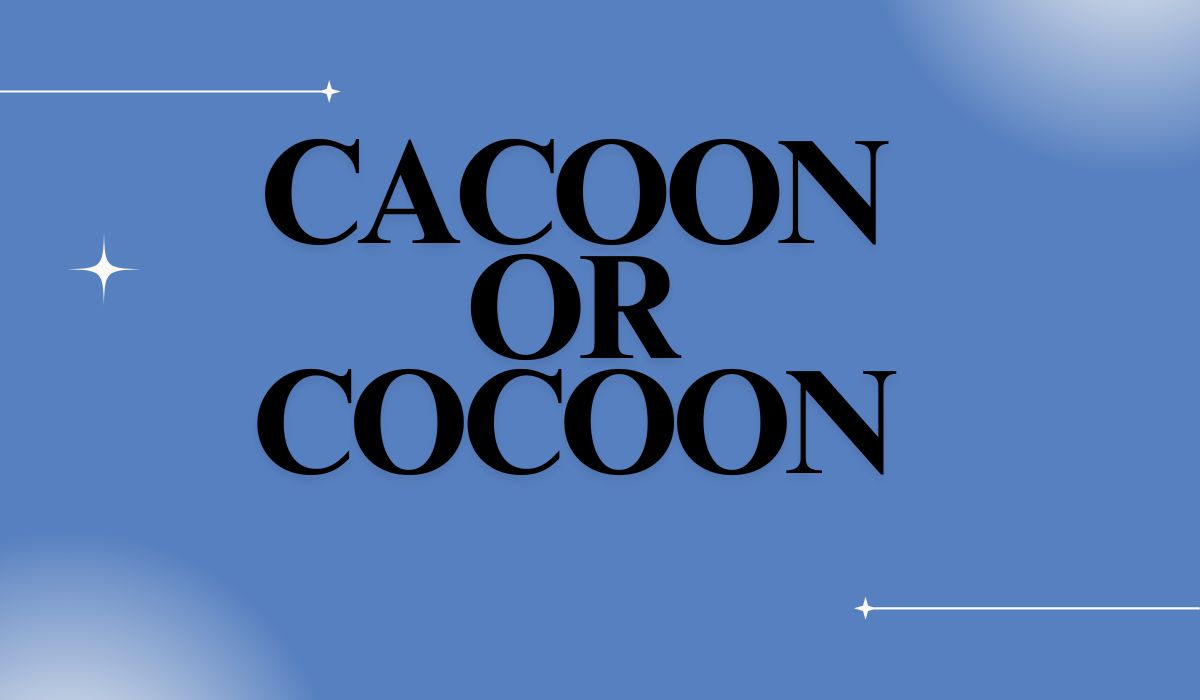Cacoon or Cocoon is a question that often confuses English learners and writers. Although these words sound similar, their meanings, contexts, and origins are very different. Cacoon primarily refers to a botanical term, specifically the snuffbox bean (Fevillea cordifolia), which originates from the West Indies.
In contrast, Cocoon is widely known as the protective casing spun by insects during their metamorphosis, and it also has metaphorical uses in literature and everyday life. Understanding the difference is essential for proper grammar and communication. This guide will explain meanings, differences, usage tips, and common mistakes, helping you write confidently.
Understanding Cacoon
Cacoon is a rare botanical term used to describe a tropical plant known as the snuffbox bean. Its scientific name is Fevillea cordifolia, and it is native to the West Indies, historically valued for its medicinal uses. First recorded in 1797, this plant produces pods that can resemble protective casings, which may be why the name evokes similarity with cocoon. Unlike cocoon, Cacoon is almost never used outside botanical or academic contexts.
Writers and students often mistakenly use it when referring to insects, which is incorrect. Remembering its botanical origin is essential, and understanding its place in plant studies helps avoid common spelling mistakes.
Understanding Cocoon
Cocoon is a term most commonly associated with insects, specifically the pupal stage of moths and butterflies. During this stage, the insect spins a protective casing to shelter itself while undergoing metamorphosis. The word also carries metaphorical meaning, representing safety, protection, or a personal retreat. For example, “She retreated into the cocoon of her home during winter.” Beyond biology, cocooning can describe self-care, comfort, or any protective environment
. Historically, cocoons have been significant in silk production, with humans harvesting silk fibers from silkworm cocoons for centuries. Proper understanding of cocoon ensures accurate usage in both literal and figurative contexts.
Cacoon vs Cocoon Key Differences
Knowing the difference between Cacoon and Cocoon is crucial to avoid confusion. While Cacoon is a botanical term referring to the snuffbox bean, Cocoon is biological and metaphorical, describing the protective casing spun by insects.
Their pronunciation is similar, which often leads to errors in writing. Context is the key to distinguishing them: use Cacoon when discussing plants, seeds, or botanical studies, and Cocoon when referring to insects, shelter, or metaphorical protection. Misuse of either can mislead readers. Visual aids, like tables comparing meaning, origin, and usage, can help retain clarity and accuracy when writing or editing.
| Aspect | Cacoon | Cocoon |
| Field | Botanical | Biological & metaphorical |
| Meaning | Snuffbox bean (Fevillea cordifolia) | Protective casing, shelter |
| Usage | Rare, academic | Common, general English |
| Historical Reference | First known use: 1797 | Silk production, metamorphosis studies |
Common Mistakes and Tips for Correct Usage
Even experienced writers sometimes confuse Cacoon and Cocoon. One common mistake is using Cacoon to describe an insect pupa, which is incorrect. Another is using Cocoon when referring to the tropical Cacoon plant. To avoid these errors, associate Cacoon with plants and Cocoon with insects or shelter.
Mnemonic devices can help: “Cacoon grows; Cocoon protects.” Example sentences are also useful: “The researcher studied the Cacoon plant” versus “The caterpillar spun a cocoon before emerging as a butterfly.” Understanding context and practicing these distinctions will improve your writing precision and confidence in English usage.
Practical Examples of Cacoon and Cocoon in Sentences
Using Cacoon and Cocoon in context ensures clarity. Here are some practical examples:
- Cacoon (botanical): “The Cacoon plant’s pods are used for traditional remedies in the West Indies.”
- Cocoon (insect): “The silkworm spun a delicate cocoon before entering its pupal stage.”
- Cocoon (metaphorical): “She spent the weekend in the cocoon of her home, reading and relaxing.”
These examples demonstrate that Cacoon rarely appears outside academic or botanical discussions, while Cocoon is widely applicable in both literal and figurative contexts. Including such sentences in your writing improves readability and comprehension.
Interesting Facts About Cacoon and Cocoon
- The Cacoon plant is also called the snuffbox bean, historically valued for medicinal purposes.
- Cocooning has evolved from its insect origins to represent self-care and personal protection in modern language.
- Silk is harvested from cocoons, demonstrating its economic and cultural importance.
- The metaphorical use of cocoon symbolizes growth, transformation, and safety, making it prevalent in literature and everyday expressions.
- Cacoon has its first known use in 1797, showing its longstanding but specialized role in botanical terminology.
Conclusion
In conclusion, understanding Cacoon or Cocoon is essential for proper English usage. Cacoon refers to a specialized botanical term, while Cocoon is widely used in biological and metaphorical contexts. Correct usage not only improves clarity but also reflects strong language skills.
By learning the differences, practicing examples, and applying mnemonic tips, you can confidently avoid mistakes. Remember: Cacoon grows; Cocoon protects. Using these words correctly in sentences, articles, or conversation enhances your writing and ensures effective communication in English.
FAQs About Cacoon and Cocoon
Is Cacoon ever correct in English?
Yes, Cacoon is correct only in botanical or academic contexts when referring to the tropical plant called the snuffbox bean (Fevillea cordifolia).
What is the difference between Cacoon and Cocoon?
Cacoon refers to a plant, whereas Cocoon is the protective casing spun by insects during their pupal stage.
How do I remember the correct spelling?
A simple way is: Cacoon = Plant, Cocoon = Covering/Protection. Associating the word with its meaning helps prevent mistakes.
Can Cocoon be used metaphorically?
Yes, Cocoon can describe a protective or sheltered environment, like “She retreated into the cocoon of her home.”
What is the botanical significance of Cacoon?
It’s a tropical plant native to the West Indies, historically used for medicinal purposes and producing unique pods resembling protective coverings.
When should I use Cocoon instead of Cacoon?
Use Cocoon in everyday English, biology, or metaphorical contexts, and reserve Cacoon for botanical references.
Are there common mistakes people make with Cacoon and Cocoon?
Yes, the most common mistake is confusing Cacoon (plant) with Cocoon (insect casing), especially in writing or casual conversation.








